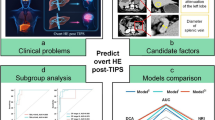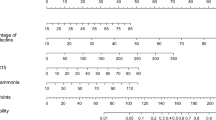Abstract
Purpose
Data on medium- and long-term efficacy and safety of Transjugular intrahepatic portosystemic shunt (TIPS) using Viatorr stents in Chinese patients are limited. This study aimed to evaluate the 5-year mortality and the incidence of overt hepatic encephalopathy (OHE) after Viatorr stent insertion, and construct a model to predict post-TIPS OHE preoperatively.
Methods
One hundred thirty-two patients undergoing Viatorr stent insertion in our institution between August 2016 and December 2019 were included, and randomly divided into training and validation cohort at a 70/30 ratio. Patients were followed up until death or the end date of follow-up (December 31st, 2021). The primary end point was all-cause mortality, and the secondary end points were OHE, variceal rebleeding, recurrent ascites and shunt dysfunction.
Results
The 1-, 2-, 3-, 4- and 5-year cumulative survival rates were 92.4%, 87.9%, 85.3%, 80.2% and 80.2%, respectively. Post-TIPS OHE and Child-Pugh grade were independent prognostic factors. The rates of variceal rebleeding, recurrent ascites, shunt dysfunction and post-TIPS OHE were 9.1%, 14.3%, 5.3% and 28.0%, respectively. The variables of nomogram predicting post-TIPS OHE included age, diabetes and ascites grade. The area under time-dependent receiver operation characteristic (ROC) curve (AUC) in training and validation cohort were 0.806 and 0.751, respectively. The decision curve analysis (DCA) showed good net benefit both in training and validation cohort.
Conclusion
Post-TIPS OHE and Child-Pugh grade are independent prognostic factors for early mortality in cirrhosis patients, thus we construct a simple and convenient prediction model for post-TIPS OHE to identify high-risk patients preoperatively.
Graphical abstract




Similar content being viewed by others
References
1 Pinchot, J. W. et al. ACR Appropriateness Criteria® Radiologic Management of Portal Hypertension. Journal of the American College of Radiology : JACR 18, S153-s173, doi:https://doi.org/10.1016/j.jacr.2021.02.013 (2021).
2 Boike, J. R. et al. North American Practice-Based Recommendations for Transjugular Intrahepatic Portosystemic Shunts in Portal Hypertension. Clinical gastroenterology and hepatology : the official clinical practice journal of the American Gastroenterological Association, doi:https://doi.org/10.1016/j.cgh.2021.07.018 (2021).
3 Richter, G. M., Noeldge, G., Palmaz, J. C. & Roessle, M. The transjugular intrahepatic portosystemic stent-shunt (TIPSS): results of a pilot study. Cardiovascular and interventional radiology 13, 200-207, doi:https://doi.org/10.1007/bf02575474 (1990).
4 Bureau, C. et al. Patency of stents covered with polytetrafluoroethylene in patients treated by transjugular intrahepatic portosystemic shunts: long-term results of a randomized multicentre study. Liver international : official journal of the International Association for the Study of the Liver 27, 742-747, doi:https://doi.org/10.1111/j.1478-3231.2007.01522.x (2007).
5 Wang, L. et al. Efficacy of covered and bare stent in TIPS for cirrhotic portal hypertension: A single-center randomized trial. Scientific reports 6, 21011, doi:https://doi.org/10.1038/srep21011 (2016).
6 Trebicka, J. et al. Rebleeding and mortality risk are increased by ACLF but reduced by pre-emptive TIPS. Journal of hepatology 73, 1082-1091, doi:https://doi.org/10.1016/j.jhep.2020.04.024 (2020).
7 Tripathi, D. et al. Transjugular intrahepatic portosystemic stent-shunt in the management of portal hypertension. Gut 69, 1173-1192, doi:https://doi.org/10.1136/gutjnl-2019-320221 (2020).
8 Bettinger, D. et al. Procedural and shunt-related complications and mortality of the transjugular intrahepatic portosystemic shunt (TIPSS). Alimentary pharmacology & therapeutics 44, 1051-1061, doi:https://doi.org/10.1111/apt.13809 (2016).
9 Bai, M. et al. Predictors of hepatic encephalopathy after transjugular intrahepatic portosystemic shunt in cirrhotic patients: a systematic review. J Gastroenterol Hepatol 26, 943-951, doi:https://doi.org/10.1111/j.1440-1746.2011.06663.x (2011).
10 Yang, Y. et al. Prediction of overt hepatic encephalopathy after transjugular intrahepatic portosystemic shunt treatment: a cohort study. Hepatology international 15, 730-740, doi:https://doi.org/10.1007/s12072-021-10188-5 (2021).
11 Yin, X. et al. A nomogram to predict the risk of hepatic encephalopathy after transjugular intrahepatic portosystemic shunt in Cirrhotic Patients. Scientific reports 10, 9381, doi:https://doi.org/10.1038/s41598-020-65227-2 (2020).
12 Li, S. et al. High expression of PARD3 predicts poor prognosis in hepatocellular carcinoma. Scientific reports 11, 11078, doi:https://doi.org/10.1038/s41598-021-90507-w (2021).
13 Heagerty, P. J., Lumley, T. & Pepe, M. S. Time-dependent ROC curves for censored survival data and a diagnostic marker. Biometrics 56, 337-344, doi:https://doi.org/10.1111/j.0006-341x.2000.00337.x (2000).
14 Vickers, A. J. & Elkin, E. B. Decision curve analysis: a novel method for evaluating prediction models. Medical decision making : an international journal of the Society for Medical Decision Making 26, 565-574, doi:https://doi.org/10.1177/0272989x06295361 (2006).
15 Wang, Y. et al. Prognostic nomogram for intrahepatic cholangiocarcinoma after partial hepatectomy. Journal of clinical oncology : official journal of the American Society of Clinical Oncology 31, 1188-1195, doi:https://doi.org/10.1200/jco.2012.41.5984 (2013).
Han, H. et al. Diagnostic value of conventional ultrasound and shear wave elastography in detecting transjugular intrahepatic portosystemic shunt dysfunction. Acta radiologica (Stockholm, Sweden : 1987) 62, 1575-1582, doi:https://doi.org/10.1177/0284185120975183 (2021).
Collaborators, G. D. a. I. I. a. P. Global, regional, and national incidence, prevalence, and years lived with disability for 328 diseases and injuries for 195 countries, 1990-2016: a systematic analysis for the Global Burden of Disease Study 2016. Lancet (London, England) 390, 1211-1259, doi:https://doi.org/10.1016/s0140-6736(17)32154-2 (2017).
18 Li, M. et al. Burden of Cirrhosis and Other Chronic Liver Diseases Caused by Specific Etiologies in China, 1990-2016: Findings from the Global Burden of Disease Study 2016. Biomedical and environmental sciences : BES 33, 1-10, doi:https://doi.org/10.3967/bes2020.001 (2020).
19 Perello, M. P. et al. Long-term follow-up of transjugular intrahepatic portosystemic shunt (TIPS) with stent-graft. Diagnostic and interventional radiology (Ankara, Turkey) 25, 346-352, doi:https://doi.org/10.5152/dir.2019.18416 (2019).
Perarnau, J. M. et al. Covered vs. uncovered stents for transjugular intrahepatic portosystemic shunt: a randomized controlled trial. Journal of hepatology 60, 962-968, doi:https://doi.org/10.1016/j.jhep.2014.01.015 (2014).
21 Rössle, M. TIPS: 25 years later. Journal of hepatology 59, 1081-1093, doi:https://doi.org/10.1016/j.jhep.2013.06.014 (2013).
Interventionalists, T. C. C. o. CCI clinical practice guidelines: management of TIPS for portal hypertension (2019 edition). Chinese Journal of Hepatology 27, 582-593, doi:https://doi.org/10.3760/cma.j.issn.1007-3418.2019.08.002 (2019).
23 Maleux, G. et al. Early and long-term clinical and radiological follow-up results of expanded-polytetrafluoroethylene-covered stent-grafts for transjugular intrahepatic portosystemic shunt procedures. European radiology 14, 1842-1850, doi:https://doi.org/10.1007/s00330-004-2359-4 (2004).
24 Chen, S. et al. Recurrent variceal bleeding and shunt patency: prospective randomized controlled trial of transjugular intrahepatic portosystemic shunt alone or combined with coronary vein embolization. Radiology 268, 900-906, doi:https://doi.org/10.1148/radiol.13120800 (2013).
25 Nilsson, E., Anderson, H., Sargenti, K., Lindgren, S. & Prytz, H. Clinical course and mortality by etiology of liver cirrhosis in Sweden: a population based, long-term follow-up study of 1317 patients. Alimentary pharmacology & therapeutics 49, 1421-1430, doi:https://doi.org/10.1111/apt.15255 (2019).
26 Trebicka, J. et al. Smaller-Diameter Covered Transjugular Intrahepatic Portosystemic Shunt Stents Are Associated With Increased Survival. Clinical gastroenterology and hepatology : the official clinical practice journal of the American Gastroenterological Association 17, 2793-2799.e2791, doi:https://doi.org/10.1016/j.cgh.2019.03.042 (2019).
27 Pohl, J., Gebauer, B., Gebert, P., Tacke, F. & Wree, A. Predicting survival after TIPS: Child Pugh score is not inferior to MELD and FIPS score - back to basics? Journal of hepatology 75, 1505-1506, doi:https://doi.org/10.1016/j.jhep.2021.07.006 (2021).
28 Wan, Y. M. et al. Transjugular Intrahepatic Portosystemic Shunt:The Impact of Portal Venous Pressure Declines on Shunt Patency and Clinical Efficacy. Academic radiology 26, 188-195, doi:https://doi.org/10.1016/j.acra.2018.05.015 (2019).
29 Wang, Q. et al. Eight millimetre covered TIPS does not compromise shunt function but reduces hepatic encephalopathy in preventing variceal rebleeding. Journal of hepatology 67, 508-516, doi:https://doi.org/10.1016/j.jhep.2017.05.006 (2017).
30 Luo, X. et al. Long-term patency and clinical outcome of the transjugular intrahepatic portosystemic shunt using the expanded polytetrafluoroethylene stent-graft. PLoS One 14, e0212658, doi:https://doi.org/10.1371/journal.pone.0212658 (2019).
31 Montagnese, S. et al. Hepatic encephalopathy 2018: A clinical practice guideline by the Italian Association for the Study of the Liver (AISF). Digestive and liver disease : official journal of the Italian Society of Gastroenterology and the Italian Association for the Study of the Liver 51, 190-205, doi:https://doi.org/10.1016/j.dld.2018.11.035 (2019).
32 Labenz, C. et al. Association between diabetes mellitus and hepatic encephalopathy in patients with cirrhosis. Alimentary pharmacology & therapeutics 52, 527-536, doi:https://doi.org/10.1111/apt.15915 (2020).
33 Bernardi, M., Moreau, R., Angeli, P., Schnabl, B. & Arroyo, V. Mechanisms of decompensation and organ failure in cirrhosis: From peripheral arterial vasodilation to systemic inflammation hypothesis. Journal of hepatology 63, 1272-1284, doi:https://doi.org/10.1016/j.jhep.2015.07.004 (2015).
34 Liu, J. et al. The combination of Child-Pugh score and quantitative CT-based spleen volume could predict the risk of hepatic encephalopathy after transjugular intrahepatic portosystemic shunt creation. Abdominal radiology (New York) 46, 3464-3470, doi:https://doi.org/10.1007/s00261-021-02972-6 (2021).
35 Cai, W., Zheng, B., Lin, X., Wu, W. & Chen, C. Prediction of Patient Hepatic Encephalopathy Risk with Freiburg Index of Post-TIPS Survival Score Following Transjugular Intrahepatic Portosystemic Shunts: A Retrospective Study. International journal of general medicine 15, 4007-4016, doi:https://doi.org/10.2147/ijgm.S359918 (2022).
Acknowledgements
This study was supported by grants from the Science Foundation of Education Department of Yunnan province (Grant No. 2022J0243) and the Clinical Research Program of the Second Affiliated Hospital of Kunming Medical University (Grant No. ynIIT2022009).
Author information
Authors and Affiliations
Corresponding author
Ethics declarations
Competing interests
The authors declare that they have no competing interests.
Ethical approval
The study protocol was approved by the Ethics Committee of the Second Affiliated Hospital of Kunming Medical University (No. PJ-2022-147).
Research involving human and animal participants
All procedures performed in studies involving human participants were in accordance with the ethical standards of the institutional and/or national research committee and with the 1964 Helsinki declaration and its later amendments or comparable ethical standards. For this type of study formal consent is not required.
Informed consent
For this type of study informed consent is not required. This study has obtained IRB approval from (indicate the relevant board) and the need for informed consent was waived.
Additional information
Publisher's Note
Springer Nature remains neutral with regard to jurisdictional claims in published maps and institutional affiliations.
Rights and permissions
Springer Nature or its licensor (e.g. a society or other partner) holds exclusive rights to this article under a publishing agreement with the author(s) or other rightsholder(s); author self-archiving of the accepted manuscript version of this article is solely governed by the terms of such publishing agreement and applicable law.
About this article
Cite this article
Li, K., Cheng, Y., Zhao, R. et al. Prediction of mortality and overt hepatic encephalopathy undergoing transjugular intrahepatic portosystemic shunt: a retrospective cohort study. Abdom Radiol 49, 908–918 (2024). https://doi.org/10.1007/s00261-023-04086-7
Received:
Revised:
Accepted:
Published:
Issue Date:
DOI: https://doi.org/10.1007/s00261-023-04086-7




